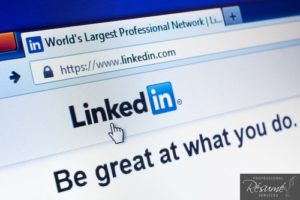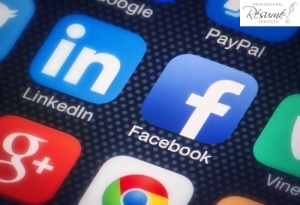When you’re in the middle of a job hunt, it can be hard to know which resources to focus on most and which are worth your while. While the Internet—and especially social media—has been brushed off in the past as a means of finding work, it now can serve as an extremely valuable tool during your job search efforts. Here’s how you can make the most of it!
1. Communicate
Social media is just that: social! Now is a prime opportunity to try and reach out to other people in your industry. Many of today’s social media platforms feature chat rooms about a myriad of subjects. You can easily find one related to your chosen industry and get to know other professionals in your area of expertise. They can help point you in the right direction as far as who’s hiring and what’s going on in your field.
2. Take Advantage of Popular Social Media Platforms
Thanks to their widespread usage, you may have come to associate the most popular social media sites, like LinkedIn and Facebook, as either purely for socialization and fun, or are simply skeptical as to whether they can really help you during your job search. As it turns out, this is one situation where you should truly believe the hype!
While sites Twitter, Facebook and others like it are most commonly used for social networking, you don’t want to discount the networking aspect. If you play your cards right and focus your efforts on business, you can use your social media accounts to forge worthwhile connections that can lead you to better job opportunities. Now would be a great time to create your LinkedIn profile if you haven’t already.
3. Google Yourself
While this may sound a bit vain, you’ll want to Google yourself before you set up any social media accounts just for the sake of seeing what comes up. Letting this go unchecked means you risk the chance of potential employers running into something unsavory when (and not if!) they look you up. You’re better off playing it safe and checking up on what’s associated with you on the Internet. Otherwise, it could end up costing you valuable job opportunities.
4. Be Direct
You don’t need to be discreet about your job search! Let those close to you know you’re in the midst of a hunt. You’ll need all the help you can get, and you never know where great connections will come from! Even if they don’t know any people who can directly provide you with work, they’ll be able to keep a look out for opportunities for you.
5. Focus on Networking
One of the best and most important aspects of any social media platform is its ability to quickly and easily put you in contact with millions of people, regardless of location. Be sure to use this to advantage! This will a key element to your Facebook and LinkedIn profile development. By researching the higher ups of the companies you’re interested in working for, you’ll know how to frame your social media accounts to better appeal to them. It will also be easier for you to get in touch with them and make a good impression.
We hope these tips will help you utilize social media far more easily as you look for your next career position. Of course, if you find yourself overwhelmed or confused, you can always turn to LinkedIn profile writing services to help you make the most of professional social media usage. Don’t hesitate to turn to your nearest resume writing service for your other job search needs!
While social media is a relatively new development, it has made waves around the world thanks to its exceptionally wide reach. It can now be used to influence the world, whether it’s through helping others form lasting friendships or simply staying in touch with those they love, inspire political change or even communicate consumer needs to businesses across the globe. Anyone in the middle of a job search can benefit from social media to land the perfect new job. Here’s what you can do to boost your success!
Utilize Your Options Well
While social media is an amazing means of connecting with employers and fellow professionals, you can’t try the spaghetti method by throwing options wildly and going with whatever adheres. You have to plan exactly how to use your social media profiles to their fullest and stay diligent with it. Creating a
LinkedIn profile is a good place to start because it will put you in touch with millions of professionals in your industry, as well as businesses looking for someone with your talents. You’ll ultimately want to sign up with more than one service because this will give you the chance to collect a greater number of opportunities and news about jobs available to you out there.
We must highlight the fact maintaining any kind of social media presence takes time and investment. For instance, while writing a tweet may take up only 140 characters, you have to plan how to use those characters as efficiently as possible to market yourself. Before you even think of signing up for that first account, you’ll want to consider how you’ll go about advertising yourself and which channels will serve you best for this goal.
Don’t Discount Social Media Entirely
Quite a few people still dismiss social media as a vapid pastime with no hope of generating serious forms of engagement. As time has repeatedly proven, however, this viewpoint is several shades of wrong. Millions of businesses in this day and age have caught on to the social media wave and are using it to reach out to more consumers than ever before. In fact, many of today’s job board sites also have social media accounts you can follow so you can stay on top of opportunities to apply.
If businesses and job boards can take proper advantage of it, so can you! Proper
LinkedIn profile development will be key to establishing your professional online presence so you’ll want to get on-board with what social media can offer you and reap the benefits of those opportunities.
Take Advantage of the ‘Social’ Aspect of Social Media
There’s no point in using any social media platform for your job search if all you’re planning to do is push out posts and never interact with anyone. Reaching out to other professionals can help you stay in the know as far as what today’s job boards are posting. You’ll soon find a wealth of opportunities pooling toward you from across the web, likely from job boards you’ve never heard of before!
If the idea of social media intimidates you, you aren’t alone. You can depend on a
LinkedIn profile writing service to help you get started. We recommend to
get in touch with your nearest resume writing service and start learning the ropes today!
 For most of us, networking isn’t our favorite thing. It’s more of a “must do” than a “want to.” Networking is boring and can be absolutely terrifying. Meeting strangers at stuffy events where you wish a cocktail or three could be downed isn’t exactly fun.
For most of us, networking isn’t our favorite thing. It’s more of a “must do” than a “want to.” Networking is boring and can be absolutely terrifying. Meeting strangers at stuffy events where you wish a cocktail or three could be downed isn’t exactly fun.
The problem is networking is an absolute “must” in today’s business world. You have to network to get ahead in today’s business climate. If you cannot build a network, you cannot achieve your highest possible level of success.
Luckily, networking isn’t just business cards and small talk these days. Things like LinkedIn profile development and more social media sites play a huge role. So here’s how to make the most of your networking efforts:
It Goes Both Ways
When you’re flexing your networking muscles, make sure to remember that it goes both ways. You need to introduce yourself, talk about your company and more. So does the individual you’re speaking with. Make sure you give the other person time to explain their business and what they do. Nobody likes a selfish networker.
Get Your Mingle On
Instead of networking at stuffy events filled with equally stuffy people, try combining this mandatory activity with things you actually like doing. Join a yoga or cooking class. Find a professionals golf group. Get on Groupon and see if anything strikes your fancy. Everyone is a potential client, and everyone is easier to talk to in a social situation. Networking isn’t all about your LinkedIn profiles and email signature.
Find Your Focus
You can’t network and build a relationship with every single person you “know” right now. It’s mentally, physically, and emotionally impossible. So when deciding who to reach out to, think about who you could help and who could help you. Think back to your past about people who have built an extensive network and could possibly offer an important introduction.
Smooth Talking to Second
Not base! Get your mind off all that. We’re talking about securing a second meeting with a potentially valuable asset to your network. As you work the room at a networking event and meet someone who could be valuable to you, work to build a connection with the individual and then suggest a second meeting before getting contact information.
Stay Socializing
Networking in person is great. Keeping your executive bio on hand is important. However, times have changed. These days focusing on LinkedIn profile development may be more important than any of the other factors on this list. There are more movers and shakers on LinkedIn than you’ll ever find at a networking event.
Just remember: when making connections on LinkedIn, you need to build relationships online and then take them offline, if possible. One face-to-face meeting with an influencer from the best business social media site could mean more to your career than you could ever imagine.

Your LinkedIn profile can make or break your chances of getting hired.
When you are a job seeker looking for a C-level executive position, not only must you have a LinkedIn profile, but that profile must be outstanding. Your profile should be succinct and to the point, as well as provide critical information upfront so a recruiter doesn’t have to wade through expendable verbiage to get to the details they’re most interested in.
Some Critical Components to Optimize LinkedIn Profile Benefits
First, you want to include relevant keywords that will help a recruiter find your profile. Review some recent C-level job postings you’re interested in and look for words most frequently used in these postings. Incorporate these words in a natural way in your profile so it will catch recruiters’ attention.
Also, make sure to build up your network of connections, as well as give and request recommendations from past employers, co-workers and those who work under you. Recruiters place significant weight on what third-party sources have to say about you and the words they use to describe you. This is valuable information that paints a picture of your leadership style.
Don’t underestimate the importance of the photo you choose for your profile. You are applying for a high-level managerial position, you’re not trying to get a date or impress your buddies. Keep it professional; your photo should depict you looking like you would sitting in your corner office, not on the golf course.
Finally, while it may be true you are on LinkedIn for the sole purpose of finding your next C-level opportunity, you definitely do not want to broadcast that fact. You lose your intrigue if you appear desperate.
What Tone Should You Take When LinkedIn Profile Writing?
Obviously, your verbiage should be professional, but many professionals agree the tone should be relatively informal. It only makes sense to use first person “I” because you are describing yourself. Even if you hire a LinkedIn profile writing service, as many upper-level executives do, the writer should write in first person. Avoid being too wordy, but also being overly dry. Any recruiter who sees your profile will be interested not just in your qualifications, but in your personality.
One Special C-level LinkedIn Consideration
It may seem counterintuitive, but if you are already employed as a CEO, CFO or COO, it’s a good idea to change your privacy settings to ensure your connections aren’t visible to the public. Doing this is simple. On LinkedIn, you will find a setting that allows you to choose who can see your connections. Change the setting to “just you.” This protects you from current competitors mining your connections and gaining insight into professional relationships you’d rather them not know about. Similarly, scroll through your public profile privacy settings and opt out of any that may jeopardize your odds of landing a better position. If, for example, you belong to partisan or controversial groups or organizations, you can opt to keep these off of your public profile.
It’s not good enough to simply have a LinkedIn presence. If you’re a C-level professional, your presence should be complete and well-crafted, not simply an afterthought.

Your LinkedIn profile should tell potential employers why you’re a good candidate.
If you’re seeking an executive-level position and you’re not on social media, you need to be. A growing number of employers peruse top candidates’ social media accounts as part of the hiring process. The key to making social media sites work in your favor is to use them strategically.
How Do Employers Use Social Media?
According to one survey of more than 2,300 HR professionals, nearly 40 percent log on to social media to screen applicants. What are they looking for? Employers use social media to learn about the personality and character of potential employees. By the time they log on to do their research, they already know much about your qualifications, education and professional experience, thanks to your resume and cover letter. They check out sites like LinkedIn, Facebook and even Twitter to learn more about who you are as a person.
Will you fit into the corporate culture? Are you as qualified as your resume states you are? Hiring professionals also use social media to look for red flags indicating you would not be a good fit for their company. It goes without saying, if you’re interested in an executive position, make sure your social media accounts don’t include inappropriate photos or comments. Err on the side of caution; review your social media accounts and remove anything that could be construed as unprofessional or unseemly. If you use Facebook to keep in touch with your college buddies, make sure your profile is set to “private.”
How You Can Make Social Media Work in Your Favor
Once you’ve removed questionable content and updated your privacy settings, it’s time to consider how to use social media to your advantage. When you use social media to market yourself, you’ll want to update your online presence frequently. As such, it’s best to choose one platform to focus on. By far, the best platform to use for personal branding for senior level managers is the professional networking site, LinkedIn. Here are some tips to consider when creating or updating your LinkedIn profile.
- Complete your LinkedIn profile 100 percent.
- Summarize your qualifications, but let your personality shine through. Have you accomplished some non-work-related feat (for example, completed seven marathons or climbed Mount Kilimanjaro?) Your LinkedIn profile is an ideal opportunity to show employers you’re well-rounded. Humanize your profile to draw in readers and encourage them to want to learn more about you.
- Incorporate keywords that are frequently found in the job descriptions you’re interested in.
- Expand your network as much as possible by connecting with relatives, friends and former co-workers. The more connections the better.
- Cement your status as an industry expert by participating in discussions or posting to blogs.
Help Is Available
Marketing yourself through social media can begin to seem like a job in itself. If you find yourself feeling overwhelmed, a LinkedIn profile service can help you develop a strong, keyword-dense, value-added LinkedIn profile. If your LinkedIn profile is incomplete, outdated or simply uninspired, contact us. We’re the missing link to make LinkedIn work for you.

If you are an executive, then you should be on LinkedIn. Don’t think of it as just another social media website because it is not. It is a networking site for business professionals, and simply having a presence can improve your visibility tremendously. Many executives are finding that out the easy way.
Here are 5 solid reasons you should be on LinkedIn right now:
- Many professionals find their next job through contacts they meet on LinkedIn. The social network used to be considered the place to go when you wanted to find a job. Today, it’s much broader than that, but the networking possibilities are endless. And they often lead to better employment prospects.
- It’s a great place to generate leads for your business.
- You have the ability to share your content with your target audience seamlessly. If you are a blogger or routinely craft content on third party websites, you can share it on LinkedIn and reach your professional audience easily. No fighting through the noise on Facebook and Twitter.
- You can publish your articles on LinkedIn and give them wider visibility. You own all your content and can take it with you when you leave–if you ever leave.
- LinkedIn profile page acts like a professional online CV. Every time you make a career move–whether you change jobs, receive a certification, take a career enhancement class, get published, or earn an award for your professional achievements–you can add that to your LinkedIn profile. People do read them, and they do take notice.
Every executive should have a presence on LinkedIn, from CEO down to the middle manager who wants to be CEO.

It’s easy to approach LinkedIn like it’s a professional version of Facebook, but that is not a good idea. Many professionals very carefully do not have any overlap at all between their Facebook and LinkedIn profiles but realize that somehow, somebody will figure out the connections so they are still careful online. In fact, that’s the first mistake you can make:
Common Mistakes Seen On LinkedIn
- Not monitoring the way your name and identity (brand) show up online keeps you from seeing when there’s a problem that needs to be addressed. Set up a Google Alert on all variations of your name and use a few search engines to see how you look to a potential employer who is researching your suitability for an opening.
- No profile picture, or an unprofessional profile picture make an impression all right, an impression that you don’t care about your career enough to use a suitable photograph.
- An incomplete profile reveals your failure in completing a task and triggers questions about how you’ll complete tasks on the job. It also shows you haven’t taken the time to learn how to effectively use the tools at your disposal.
- Not updating your status with recent accomplishments or authoritative content makes you look like nothing is happening.
- Thinking LinkedIn is only for job seekers and ignoring the network until you need a job keeps you from the real benefits of professional networking.
If you are at all serious about your career, you should be regularly paying attention to how to improve your LinkedIn capabilities. There’s been plenty of tips on this blog, and we even offer professional LinkedIn Profile Development if you decide you need that service. The professional networking you have on LinkedIn isn’t like any other type of social media, and it’s worth your time and effort to learn how to avoid making mistakes.

How long did it take you to get your LinkedIn profile complete? For most of us, it was a process that took longer than we wanted it to because there’s so much to doing a LinkedIn profile correctly. In addition to having all your personal information entered accurately and completely, you must think about keywords, SEO, and technological issues that most people have no time to learn. But even if you have invested in professional services, without networking activity you can end up with a perfectly constructed profile that sits in the background like a treasure box in the back of the closet; there’s really good stuff in it, but nobody has opened it up to find out.
The LinkedIn search engine uses complicated algorithms that are unique to the site. They factor in things like your Profile, activity, and connections to come up with relevance scores that only apply to you. A good way to ensure your profile is looked at is by taking the time to become part of the LinkedIn community, updating your profile regularly from your profile page with links to articles you’re reading in your field. LinkedIn Today lets you set up newsfeeds for your interests; that’s a good place to start. Don’t forget to add in any new factors from your work experience, etc. If your resume just was updated, do it on LinkedIn too. If you need help, ask us.
The top reason to update your LinkedIn profile is because the site is not static. Your networking activity on the site keeps your profile active and gets more traffic to your page. You want to keep that treasure box out of the back of the closet and out in the living room where people will look inside to discover great things about you.








